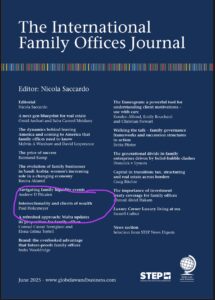11 Jul Wealth and Mental Health: Applying intersectionality to understand clients and patients of wealth
In this article, which appears in The International Family Offices Journal, Dr. Paul Hokemeyer applies the construct of to enable wealth advisors and clinicians who work with clients and patients of wealth (PoW) to provide exceptional care and service to the human beings they are privileged to serve.

The article begins by addressing the challenges faced by PoW, particularly during times of financial volatility, such as the spike in the VIX index earlier this year. Hokemeyer, a licensed marriage and family therapist and author of Fragile Power (Hazelden, 2019), explains that wealth often eclipses other aspects of a person’s identity, leading to objectification and invalidation of their humanness. He emphasizes the importance of establishing a reparative therapeutic alliance (TA) with clients, built on trust, empathy, and collaboration. This alliance allows clients to explore their identities in a safe environment and helps advisers connect with them on a deeper level.
Hokemeyer introduces the concept of intersectionality as a tool for understanding the multifaceted nature of clients’ identities. He explains that human beings are not a simple summation of their identities but a complex calculus of intersecting characteristics shaped by cultural, structural, and social contexts. Applying intersectionality to PoW challenges common prejudices, such as the assumption that wealthy individuals live stress-free lives or can buy their way out of problems. Instead, it allows advisers to see wealth as one factor among many that contribute to a client’s identity.
To illustrate this, Hokemeyer presents a case study of Lana, a 19-year-old heiress dealing with grief, injury, and identity struggles. Lana’s intersecting identities include being a bereaved daughter, an adolescent female, a global citizen, a victim of physical injury, and a woman of wealth. Her wealth, rather than providing comfort, is perceived as a curse tied to tragic events in her life. Lana’s case highlights how wealth advisers can use intersectionality to understand the nuances of their clients’ identities and provide more compassionate and effective support.
The article concludes with practical guidance for wealth advisers, informed by the American Psychological Association’s Multicultural Guidelines. Hokemeyer provides a five-point guide to help advisers apply intersectionality in their practice, enabling them to deepen trust, empathy, and connection with their clients. By viewing clients in the context of their lives and multiple identities, advisers can strengthen relationships, guide clients through challenges, and fulfill their promise of being full-service wealth advisers.
Overall, the article advocates for a more nuanced and empathetic approach to working with clients of wealth, emphasizing the importance of understanding their unique identities and experiences beyond their financial status.


Sorry, the comment form is closed at this time.